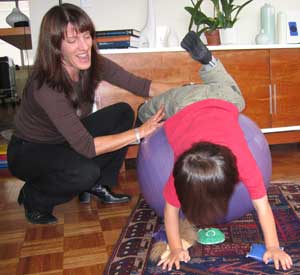What is Occupational Therapy?

Occupational therapy is a healthcare profession dedicated to helping people of all ages better perform tasks that occupy their time. For children, this means playing and learning as well as eating, getting dressed, grooming and so on. An OT provides carefully designed challenges that build on the child’s unique strengths and interests to build developmental skills such as…
Attention span and arousal level
If a child isn’t interested, fidgets constantly, or simply doesn’t look at what she is doing, she can’t learn effectively. An OT will help you discover what motivates your child, makes his body and brain ready to learn.
Sensory processing skills
A child needs to effectively use information derived from all the senses that pick up input from the environment (vision, hearing, touch, smell, and taste) as well as from inside the body (movement and internal body awareness). All this input must be registered by sensory receptors, processed in the brain, and acted upon in an adaptive way for a child to function and feel at her best.
Fine motor and gross motor skills
Many children have difficulty with fine motor skills such as drawing, using scissors, buttoning, and stringing beads. Their small hand muscles are still maturing, and they may not have developed the strength, coordination, and dexterity needed. OTs also work on gross motor skills that use “larger” muscles, such as throwing and catching a ball, climbing stairs and playground equipment, jumping and hopping, and so on.
Activities of daily living (ADLs)
Children have lots of ADL tasks to master, and most children love becoming independent with these tasks. OTs help children learn to eat with utensils, drink from a cup, get dressed and undressed, take a shower or bath, use the toilet, and handle grooming and hygiene tasks age-appropriately.
Visual-perceptual skills
From stacking blocks to doing puzzles to understanding geometry, a child must be able to perceive differences and relationships between objects in the environment. An OT can help a child to form a mental map of how the world works and where he fits in it, all of which are essential to feeling physically and emotionally secure.
Handwriting
Handwriting skills, from the basics of letter formation to taking class notes legibly, can be difficult for some children. OTs use a fun multisensory approach to handwriting, including use of touch (e.g., using a wet finger to write on a chalkboard) and sound (teaching a special story about how a specific letter is formed), and assess the best writing utensils, paper styles, and tabletop set-ups.
Assistive technology
Low-tech devices (like pencil grips) and high-tech equipment (like computers) are increasingly used in schools. An OT can help you to find the right technological solutions for your child, teach him to use it, and help integrate it into the classroom. Many OTs work with kids with mild to profound physical disabilities, helping them function at their best using wheelchairs and other ambulatory devices as well as adaptive equipment like reachers and dressing aides, and helping non-verbal clients access communication devices that enable them communicate and thrive.


Share this page: